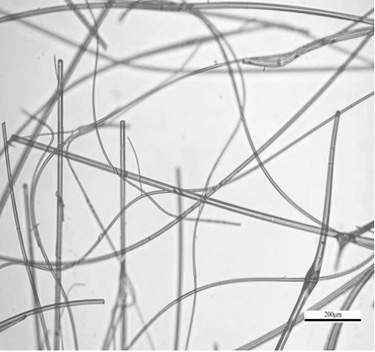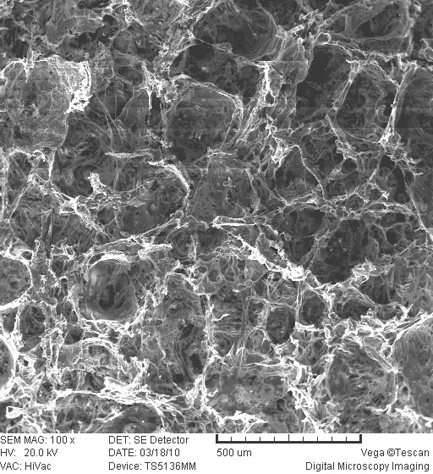Porous bracket with micro grooves on pore walls and preparation method thereof
A technology of porous scaffolds and micro-grooves, applied in medical science, prosthesis, etc., can solve the problem of difficulty in constructing micro-grooves, and achieve the advantages of large-scale production, good reproducibility, and good adhesion of cells. attached effect
- Summary
- Abstract
- Description
- Claims
- Application Information
AI Technical Summary
Problems solved by technology
Method used
Image
Examples
Example Embodiment
[0033] Example 1
[0034] Firstly, sugar fibers with a diameter of 10 μm are spun by a commercially available electric wire drawing machine. The sodium chloride is sieved with molecular sieves to obtain different particle sizes, and sodium chloride with a particle size of 180 μm-280 μm is taken for later use. Dissolve 2g of PLGA85 / 15 with a molecular weight of 359,000 in 11g of dichloromethane, then disperse 1g of sugar fiber and 30g of sodium chloride in the dichloromethane solution of PLGA, pour it into the mold, press at room temperature, after 24 hours Decompression, take out the stent, soak the stent with 200ml deionized water, change the water every 1 hour, until the 0.1mol / L silver nitrate aqueous solution is added dropwise to the leaching solution, no white precipitation appears, indicating sugar fiber and chlorine Sodium sulfide has been completely leached, and the stent that has completely leached the porogen is used to absorb most of the deionized water with filter pap...
Example Embodiment
[0035] Example 2 Dissolve 2g of PLGA85 / 15 with a molecular weight of 359,000 in 11g of dichloromethane, and then disperse 5g of sugar fiber (diameter 10μm) and 26g of sodium chloride (particle size 180μm-280μm) evenly dispersed in the dichloride of PLGA Pour the methane solution into the mold, press at room temperature, decompress after 24 hours, use 200ml deionized water holder, change the water every 0.5 hours, until 0.1mol / L silver nitrate aqueous solution is added dropwise to the leaching solution. A white precipitate appears, indicating that the sugar fiber and sodium chloride have been completely leached. The stent that has completely leached the porogen is used to absorb most of the deionized water with filter paper or toilet paper, and then vacuum-dried at a drying temperature of 20°C and a drying time of 48 hours A three-dimensional porous scaffold with grooves on the pore wall with a pore diameter of 200 μm and a porosity of 90% is obtained. The groove is 10 μm wide an...
Example Embodiment
[0036] Example 3 2g of PLGA85 / 15 with a molecular weight of 359,000 was dissolved in 17g of dichloromethane, and then 1g of sugar fiber (diameter 15μm) and 20g of sodium chloride (particle size 180μm-280μm) were uniformly dispersed in the dichloride of PLGA Pour the methane solution into the mold, press at room temperature, decompress after 24 hours, take out the stent, soak the stent with 200ml deionized water, change the water every 1 hour, until the water solution of 0.1mol / L silver nitrate is used, drip When added to the leaching solution, there is no white precipitation, so far. The stent from which the porogen has been completely leached is used to absorb most of the deionized water with filter paper or toilet paper, and then vacuum-dried, vacuum-dried, at a temperature of 20°C, and dried for 48 hours to obtain a pore wall with a pore size of 200μm and a porosity of 86% A three-dimensional porous scaffold with 15μm wide and 15μm deep grooves has a theoretical coverage of ...
PUM
| Property | Measurement | Unit |
|---|---|---|
| Diameter | aaaaa | aaaaa |
| Particle size | aaaaa | aaaaa |
| Diameter | aaaaa | aaaaa |
Abstract
Description
Claims
Application Information
 Login to view more
Login to view more - R&D Engineer
- R&D Manager
- IP Professional
- Industry Leading Data Capabilities
- Powerful AI technology
- Patent DNA Extraction
Browse by: Latest US Patents, China's latest patents, Technical Efficacy Thesaurus, Application Domain, Technology Topic.
© 2024 PatSnap. All rights reserved.Legal|Privacy policy|Modern Slavery Act Transparency Statement|Sitemap



